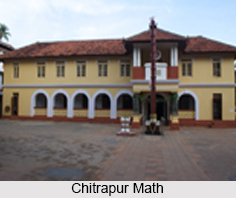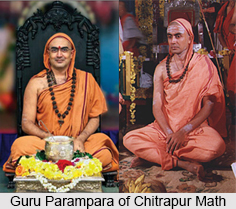 Chitrapur Math in Karnataka is the central Math for the Chitrapur Saraswat Brahmin sect. To the followers of Shri Chitrapur Math, it is a "Mansion of God". Lord Bhavanishankar, the patron deity of Math with His blessings seated here. Chitrapur Math was established in 1757 and is located at Shirali in Uttara Kannada district. The other Maths of this community are located in Gokarna, Karla, Mangalore and Mallapur.
Chitrapur Math in Karnataka is the central Math for the Chitrapur Saraswat Brahmin sect. To the followers of Shri Chitrapur Math, it is a "Mansion of God". Lord Bhavanishankar, the patron deity of Math with His blessings seated here. Chitrapur Math was established in 1757 and is located at Shirali in Uttara Kannada district. The other Maths of this community are located in Gokarna, Karla, Mangalore and Mallapur.
History of Chitrapur Math
The long history behind the establishment of the Chitrapur Math reverberate the aura of spiritualism. According to the historical accounts, at the time of the Muslim invasion in the 1400"s, the group of Smarta Gowda Saraswats mainly Kushasthalikar and Keloshikar families migrated to Karnataka. They were mostly the educators and administrators.
In the courts of the Hindu rulers of the time, some of them however managed to secure prominent positions as accountants. Hindu king of the Keladi kingdom was so overwhelmed by the meticulousness and skills of his Saraswat accountant. The King ordered that there should be a Saraswat administrator in each village in his kingdom. Eventually these Saraswats as their last name took on the name of the village. They continued to believe in Smarta tradition.
Initiation of Guru Parampara
However Saraswats were not acknowledged as true Brahmins by the local Brahmins, even though they were well respected. They felt the need of a spiritual preceptor for their community for them. To become their Guru, they begged to a Saraswat Sanyasi, Parijnanashram Swami, who was at the time visiting from North India.
 Parijnanashram Swamy accepted to guide the community and in 1708 AD, accomplished a new Math for them in Gokarna. The Jagadguru Shankaracharya of Sringeri accepted Him as a Swamiji of the Community. Swamiji therefore travelled from Gokarna to Nagar and thereafter proceeded to Sringeri. There the Jagadguru was so much struck with His learning, piety and yoga that He readily acknowledged Him as religious head. His regime lasted till 1720. His samadhi is in Bhandikeri, Gokarna.
Parijnanashram Swamy accepted to guide the community and in 1708 AD, accomplished a new Math for them in Gokarna. The Jagadguru Shankaracharya of Sringeri accepted Him as a Swamiji of the Community. Swamiji therefore travelled from Gokarna to Nagar and thereafter proceeded to Sringeri. There the Jagadguru was so much struck with His learning, piety and yoga that He readily acknowledged Him as religious head. His regime lasted till 1720. His samadhi is in Bhandikeri, Gokarna.
Shri Parijnanashram Swami ordained Shri Shankarashram Swami in 1720 AD as the second Guru. Shri Shankarashram Swamy on his way from Udupi to Gokarna and while in Chitrapur fell seriously ill at the place of Nagarkattikars (an ardent devotee) and attained Samadhi in 1757 AD. The Nagarkattikars readily offered their house for the Samadhi of Shri Shankarashram Swamy and a temple. A Math was set up there at Chitrapur near Shirali in Uttara Kannada and soon it became headquarters of the Math. As Shri Shankarashram I had not adopted any disciple that caused some concern to the continuity of this illustrious lineage.
A disciple was adopted by Sri Anandashram Swamiji in 1959, once again, from the Shuklakar family. Shrimat Parijnanashram-III was the nomenclature of this illustrious boy. He was an intelligent boy with a great interest in Vedic as well as technical studies. The Rathotsava was restarted by him since it had been discontinued by previous Swamis on account of poor economic reasons. The illustrious Swami collected antiques and artefacts to set up a Museum. He started a school for the handicapped in Bolinj at Virar near Mumbai, which is regarded as a unique institution of its kind.
In 1991, the last Swamiji Parijnanashram III attained Samadhi in Bengaluru without nominating a successor. As the reigning Guru of Chitrapur Math on February 27, 1997, Swami Sadyojat Samvit Giri was consecrated. He was given the name "Shrimat Sadyojat Shankarashram". The ordination ceremony was attended and blessed by H.H. Jagadguru Shankaracharya.
Guru Parampara of Chitrapur Math
The lineage of all Swamis of this Chitrapur Math is called Guru Parampara. The Guru Parampara of the Chitrapur Math is as following:
•H.H. Parijnanashram I Swamiji (1708-1720)
•H.H. Shankarashram I Swamiji (1720-1757)
•H.H. Parijnanashram II Swamiji (1757-1770)
•H.H. Shankarashram II Swamiji (1770-1785)
•H.H. Keshavashram Swamiji (1785-1823)
•H.H. Vamanashram Swamiji (1823-1839)
•H.H. Krishnashram Swamiji (1839-1863)
•H.H. Pandurangashram Swamiji (1863-1915)
•H.H. Anandashram Swamiji (1915-1966)
•H.H. Parijnanashram III Swamiji (1966-1991)
•H.H. Sadyojat Shankarashram Swamiji (1997-)



















